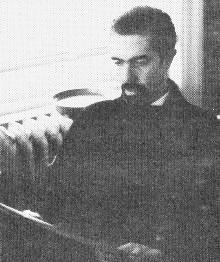
Robert Helps (1928-2001)
The University of South Florida’s School of Music is in the midst of the fourth annual Robert Helps International Composition Competition and Festival. Each year, this event pays homage to Robert Helps (1928-2001), composer/pianist, who was a faculty member at USF and one of the key promoters of new music during the second half of the twentieth century. His music is best described as belonging to New Romanticism and he had a particular fondness for piano pieces. Each year there is a $10 000 prize awarded to the most promising composition by a young composer, as well as a performance of the winning work (this year’s winner was Lyudmila German, whose Piano Sonata No. 1 we heard played excellently by USF faculty member Svetozar Ivanov as the second half of tonight’s program).
One of Helps’ traditions was to hold a concert every year on February 13 that highlighted piano repertoire. The stage of the USF Music Recital Hall would be lit with candles and as the program stated, ’embellished with an occasional feathered boa, tasteful naughtiness, and good humor.’ Tonight’s concert featured many of these traditions (minus the candles) and showcased a wide variety of twentieth-century repertoire with an innovative programming concept.
In the first half, each piece added to the piano forces of the previous. For instance, the concert started with Helps’ Saccade for four hands (1 piano), then moved to Berio’s 1965 composition, Wasserklavier for four hands (2 pianos). Although I found many of the works tonight engaging, the Berio stood out as a particularly fascinating work; the performance of Allan Armstrong and Dharshini Tambiah was nuanced and expressive. Virtually all of us were surprised that the sounds were far closer to a 19th-century aesthetic than one might have predicted (there is a YouTube recording but it is a later version for one performer. See below). Then came three works for six hands: Schnittke’s Hommage à Stravinsky, Prokofiev and Shostakovich (1 piano) and Helps’ Berceuse (2 pianos: one performer sat at one and two at the other). Next was Tomas Svoboda’s Four Visions for three pianos (6 hands), at which point USF ran out of concert grands and (unfortunately) an upright was added to the mix. Percy Grainger’s County Gardens (2 pianos, 8 hands) provided contrast to the more serious pieces preceding it, particularly due to the simply splended accessories worn by the performers, including a superbly over-sized straw hat with ample accessorizing fruit sported by Miroslava Panayotova. Next the pianists brought out the berets for Milhaud’s Paris (4 pianos, 8 hands). To end the half, we heard Cage’s Fontana Mix (4 pianos, 12 hands). As the musical material for the Cage, the performers played snippets from the pieces in which they had performed during the first half. In total, the concert involved 4 pianos, 8 composers, 9 pieces, and 13 pianists — a fitting way to celebrate Friday the 13th and pay tribute to Robert Helps.




Thank you for creating this site
After 10 years I have finally begun to assemble what I have in my collection of Helps memorabilia.
I have just posted a video of him playing the Chopin Funeral March and Finale Presto from the piano sonata, at the S.F. Conservatory on 10/9/2000.
If you would like to include it, or a link to it, on your site,
you are free to do that. I think it would be appreciated by many, there seem to be very few videos of him playing.
Ah, what a Master.
This is the URL:
http://www.youtube.com/watch?v=AKBaOTxeKD4
If you want to embed it I can send you the code.
I will be posting more.
Yours truly,
Margaret Fabrizio